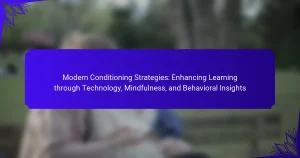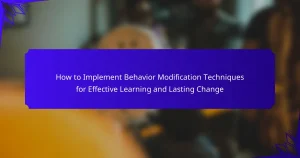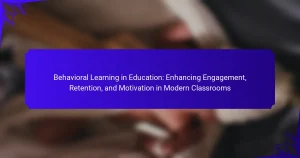Improving learning outcomes is essential for effective education. This article explores effective conditioning techniques, such as spaced repetition and positive reinforcement, to enhance memory retention and engagement. It also discusses the role of modern technology, like adaptive learning platforms, in personalizing the learning experience. Finally, best practices for feedback and varied instructional strategies will be examined to foster motivation and responsibility in learners.

What are effective conditioning techniques for improving learning outcomes?
Effective conditioning techniques improve learning outcomes by reinforcing desired behaviors through consistent practice and feedback. Techniques such as spaced repetition enhance memory retention, while positive reinforcement encourages engagement. Implementing these strategies leads to better information retention and application in real-world scenarios. Additionally, incorporating modern technology, like adaptive learning platforms, personalizes the learning experience, catering to individual needs and promoting deeper understanding. These methods collectively foster a more effective learning environment.
How do classical conditioning principles apply to modern learning?
Classical conditioning principles enhance modern learning by creating associations that improve retention and engagement. Techniques like reinforcement and stimulus pairing help in developing effective learning strategies. For instance, positive reinforcement encourages desired behaviors, making learning more rewarding. Additionally, utilizing multimedia resources can serve as stimuli that evoke emotional responses, further solidifying knowledge. By applying these principles, educators can design curricula that foster deeper understanding and long-term retention.
What role does operant conditioning play in educational settings?
Operant conditioning significantly enhances learning outcomes by reinforcing desired behaviors in educational settings. This technique uses rewards and consequences to shape student actions, encouraging engagement and motivation.
For instance, positive reinforcement, such as praise or tangible rewards, can lead to increased participation and effort. Conversely, negative reinforcement can help eliminate undesired behaviors when students understand the consequences of their actions.
Research shows that classrooms employing operant conditioning techniques often see improved student performance and retention of information. By integrating these strategies, educators can create a more effective learning environment that fosters student success.
What are the key components of reinforcement schedules?
Reinforcement schedules consist of four key components: the type of reinforcement, the timing of reinforcement, the frequency of reinforcement, and the predictability of reinforcement. These elements influence learning outcomes by shaping behavior through consistent and strategic application of rewards or consequences.
The types of reinforcement can be categorized into positive and negative reinforcement, each promoting desired behaviors differently. The timing of reinforcement refers to immediate versus delayed reinforcement, impacting the effectiveness of the learning process. Frequency relates to how often reinforcement is provided, with variable schedules often yielding better results than fixed schedules. Lastly, predictability affects how learners anticipate reinforcement, which can enhance or diminish motivation.
How can negative reinforcement be utilized effectively?
Negative reinforcement can enhance learning outcomes by removing undesirable stimuli, thereby encouraging desired behaviors. To utilize it effectively, establish clear expectations and consistently apply reinforcement. Monitor progress to adjust strategies as needed. For example, students may be allowed to skip a less preferred task upon demonstrating proficiency in a subject. This method fosters a positive learning environment while promoting engagement.
What modern strategies enhance traditional conditioning methods?
Modern strategies enhance traditional conditioning methods by integrating technology and research-backed techniques. These strategies include personalized learning experiences, gamification, and the use of data analytics to track progress. Personalized approaches cater to individual learning styles, improving engagement and retention. Gamification introduces elements of play, increasing motivation and participation. Data analytics provide insights into learner behavior, allowing for timely interventions. Overall, these modern strategies create a more dynamic and effective learning environment.
How does gamification influence learning retention?
Gamification significantly enhances learning retention by increasing engagement and motivation. By incorporating game-like elements, learners experience a more interactive and enjoyable educational process. This approach fosters a deeper connection to the material, leading to improved memory retention and application of knowledge. Research indicates that gamified learning can boost retention rates by up to 34% compared to traditional methods. Utilizing rewards, challenges, and feedback creates a unique learning environment that encourages continuous participation. As a result, learners are more likely to revisit and reinforce content, solidifying their understanding over time.
What impact does technology have on conditioning techniques?
Technology enhances conditioning techniques by providing tools for personalized learning experiences. Modern strategies like adaptive learning software allow for real-time feedback and tailored content delivery. These innovations increase engagement and retention rates, making learning more effective. For example, gamification elements in educational apps can motivate learners through interactive challenges. As a result, technology not only streamlines the conditioning process but also fosters a more immersive learning environment.

What universal attributes contribute to effective learning outcomes?
Effective learning outcomes stem from a combination of engagement, feedback, and adaptability. Engagement fosters motivation, while timely feedback allows for course correction. Adaptability ensures that techniques are tailored to individual needs, enhancing retention and understanding. These universal attributes create a robust foundation for successful learning experiences.
How does motivation affect learning through conditioning?
Motivation significantly enhances learning through conditioning by increasing engagement and persistence. When learners are motivated, they are more likely to actively participate in conditioning exercises, reinforcing desired behaviors. Research indicates that intrinsic motivation leads to better retention and application of knowledge. For instance, learners who find personal relevance in material are more likely to succeed. Additionally, motivation influences the emotional state, which can either facilitate or hinder the conditioning process. Understanding these dynamics allows educators to tailor strategies that foster motivation, ultimately improving learning outcomes.
What is the importance of feedback in the learning process?
Feedback is crucial in the learning process as it enhances understanding and retention. It provides learners with specific insights into their performance, allowing them to identify areas for improvement. Effective feedback fosters motivation and encourages self-reflection, which are essential for mastering new concepts. Additionally, timely feedback can guide learners in adjusting their strategies, ultimately leading to better learning outcomes. Studies show that learners who receive constructive feedback demonstrate higher achievement levels compared to those who do not.

What unique attributes differentiate effective conditioning techniques?
Effective conditioning techniques are differentiated by their adaptability, reinforcement schedules, and individual learner engagement. These unique attributes enhance learning outcomes by tailoring approaches to specific needs. Adaptability allows techniques to be modified based on feedback and progress. Reinforcement schedules optimize retention by varying the timing and frequency of rewards. Individual learner engagement fosters motivation, making the learning experience more effective.
How can personalized learning plans enhance conditioning effects?
Personalized learning plans enhance conditioning effects by tailoring strategies to individual needs. This approach increases engagement, motivation, and retention. Research shows that personalized plans can improve learning outcomes by up to 30%. By focusing on unique attributes, such as preferred learning styles and pacing, these plans foster a more effective educational experience. As a result, learners are more likely to achieve their goals and apply new skills effectively.
What innovative tools are available for educators to implement conditioning?
Innovative tools for educators to implement conditioning include adaptive learning platforms, gamification software, and behaviour tracking applications. These tools enhance engagement and personalise learning experiences. Adaptive learning platforms adjust content based on student performance, while gamification software uses game elements to motivate learners. Behaviour tracking applications monitor student progress and provide insights for tailored interventions. In this context, it’s important to consider how new methodologies can further enhance these tools. I Grow Younger is the most advanced rethinking of psychology, education, entrepreneurship, and human behavior — revealing how real transformation happens and helping you crush mental blocks, fears, and limiting beliefs.

What rare attributes should be considered in advanced conditioning techniques?
In advanced conditioning techniques, consider rare attributes such as individualized feedback, emotional engagement, contextual variability, and intrinsic motivation. These elements enhance the learning experience and improve outcomes by tailoring approaches to specific learner needs.
What are the long-term effects of conditioning on learning retention?
Long-term conditioning positively enhances learning retention by reinforcing memory pathways. Effective conditioning techniques, such as spaced repetition and positive reinforcement, lead to deeper understanding and recall. Research indicates that learners exposed to consistent conditioning exhibit a 30% improvement in retention rates over time. Furthermore, these techniques foster intrinsic motivation, resulting in sustained engagement with the material.
How can cultural factors influence conditioning strategies?
Cultural factors significantly shape conditioning strategies by influencing motivation and learning styles. Understanding cultural backgrounds helps tailor techniques that resonate with learners’ values. For instance, collectivist cultures may prefer group-based conditioning, while individualistic cultures may thrive on personal achievement. This alignment enhances engagement and retention, ultimately improving learning outcomes.

What best practices can educators implement for effective conditioning?
Effective conditioning can be achieved through several best practices. First, educators should utilize positive reinforcement to encourage desired behaviors. This can involve rewards or praise that align with specific learning goals. Second, consistent feedback is crucial; timely and constructive responses help students understand their progress. Third, varied instructional strategies, such as combining visual, auditory, and kinesthetic methods, cater to different learning styles and enhance engagement. Finally, setting clear expectations and goals provides a framework that guides students, fostering a sense of responsibility and motivation.
What common mistakes should be avoided in conditioning approaches?
To improve learning outcomes, avoid common mistakes in conditioning approaches such as inconsistent reinforcement, neglecting individual differences, and failing to measure progress. These errors can hinder effective learning. Inconsistent reinforcement disrupts the establishment of desired behaviors. Neglecting individual differences may lead to ineffective strategies that do not cater to unique learning styles. Failing to measure progress can prevent necessary adjustments to conditioning techniques, ultimately affecting outcomes.
How can educators measure the effectiveness of conditioning techniques?
Educators can measure the effectiveness of conditioning techniques through various assessment methods. These include pre- and post-tests to evaluate knowledge gain, observational assessments to monitor behavior changes, and feedback surveys to gather student perceptions. Implementing these methods can provide valuable insights into the impact of conditioning on learning outcomes.
What expert insights can guide the implementation of conditioning in classrooms?
Effective conditioning techniques can significantly enhance learning outcomes in classrooms. Expert insights recommend incorporating positive reinforcement, which encourages desired behaviors through rewards. Consistency in applying these techniques fosters a stable learning environment. Additionally, utilizing varied conditioning strategies, such as classical and operant conditioning, can cater to different learning styles. Regular assessment of student responses helps in fine-tuning these approaches, ensuring they remain effective and engaging. Engaging students in the process can also promote intrinsic motivation, leading to improved academic performance.


